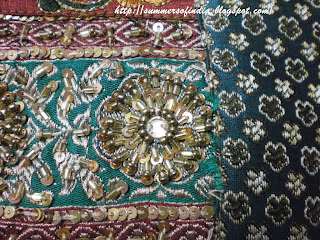Friends, I was going through some of my very old doodling clothes on which I used to practise my embroidery stitches learnt from various sources and came across this stitch.
I have learnt many from my maternal Grandma. In her childhood she studied in a school run by nuns. Such schools were called as Convents by the local people. My Gran was very proud of having studied there. Her English was impeccable. Well she learnt embroidery, crochet, sewing etc in her school. She had a very good knowledge of embroidery stitches not only the Indian ones but also those from across the world.We grand children used to sit with her and talk about her school days. We also used to learn embroidery and crochet from her. She had good memory and even after 70 years or so, she could tell us the name of the stitch both in English and local language. But alas at that time I never bothered to note down those names.
Here is one of the stitches I learned from her. She named it as Gopuram Stitch. Gopuram means Temple dome. She was not sure from where she learned this nor the name of the stitch. When she taught me I remarked that this stitch reminded me of a temple dome-so we named it as Gopuram stitch. We used to (re)name many stitches to remember them easily--:)...:)...
I have learnt many from my maternal Grandma. In her childhood she studied in a school run by nuns. Such schools were called as Convents by the local people. My Gran was very proud of having studied there. Her English was impeccable. Well she learnt embroidery, crochet, sewing etc in her school. She had a very good knowledge of embroidery stitches not only the Indian ones but also those from across the world.We grand children used to sit with her and talk about her school days. We also used to learn embroidery and crochet from her. She had good memory and even after 70 years or so, she could tell us the name of the stitch both in English and local language. But alas at that time I never bothered to note down those names.
Here is one of the stitches I learned from her. She named it as Gopuram Stitch. Gopuram means Temple dome. She was not sure from where she learned this nor the name of the stitch. When she taught me I remarked that this stitch reminded me of a temple dome-so we named it as Gopuram stitch. We used to (re)name many stitches to remember them easily--:)...:)...
If any one knows about the origin or name or any other information about this stitch, please let me know. I have not come across any similar stitch so far. Though it looks like an inverted Feather Stitch.
I have tried to put it down properly for you as tutorials:
The stitch belongs to Chain Stitch or Looped Stitches family. It can be stitched on any fabric-that is this is not a counted thread stitch.
STEP-1
The stitch belongs to Chain Stitch or Looped Stitches family. It can be stitched on any fabric-that is this is not a counted thread stitch.
STEP-1
 |
| Fig-1 |
STEP-2
 |
| Fig-2 |
Bring out the needle up through the fabric from underside at point 'A'.
STEP-3
 |
| Fig-3 |
STEP-4
 |
| Fig-4 |
Now insert the needle at 'B' a little away from 'A', going under the fabric and come out at 'C'. Loop the thread from left to right from under the needle forming a loop. Now pull the needle to get the first stitch or loop.
This is almost like a chain stitch, except that that in chain stitch we insert needle at A where as here we leave some space in between.
STEP-5
 |
| Fig-5 |
Similarly make another loop from 'F' to 'G'.
 |
| Fig-6 |
STEP-Final
Anchor with a little straight stitch at 'H'. We have completed the basic part of the stitch. it should look like this one as shown below.
 |
| Fig-7 |
The points A, B, D and F should be equidistant from each other. I have put more space between points, A,B,D and F (Fig-6)so that the stitch is clear to you.
Similarly points C, E, G and H should also be equidistant from each other.
Also notice that point 'C' should be a little to the right of A and so on and not mid point of A and B. That is the original stitch taught to me (a part of it).
Actually there is more to the stitch I learnt. I will be posting it in my next post.
Here I have tried to vary the stitch for my sampler.
 |
| Fig-8 |
 |
| Fig-9 |
 |
| Fig-10 |
BEST SUITED FOR:
As a border around the necks, sleeves and hems of blouses, kurtis or tunics, skirts for decorating CQ blocks and on pillows, cushion covers, saris etc.
I am still practising the stitch and trying to build up a sampler. The best part is yet to come. So watch out for more...
Practise the stitch and please do mail me your innovations with the stitch so that we all can share them...































